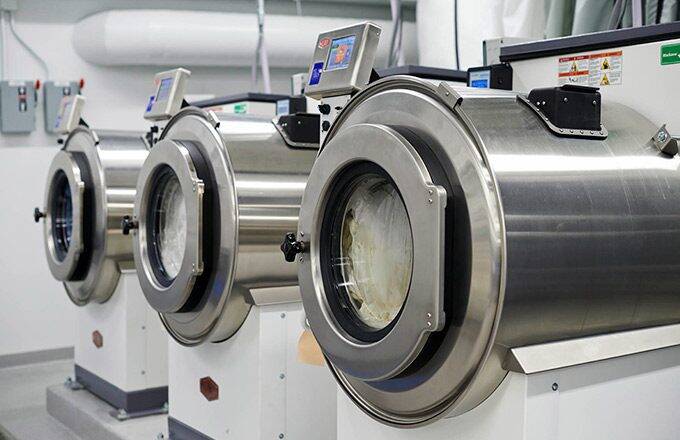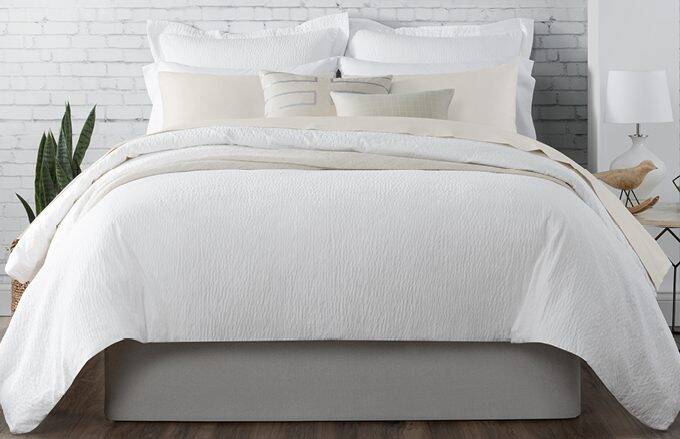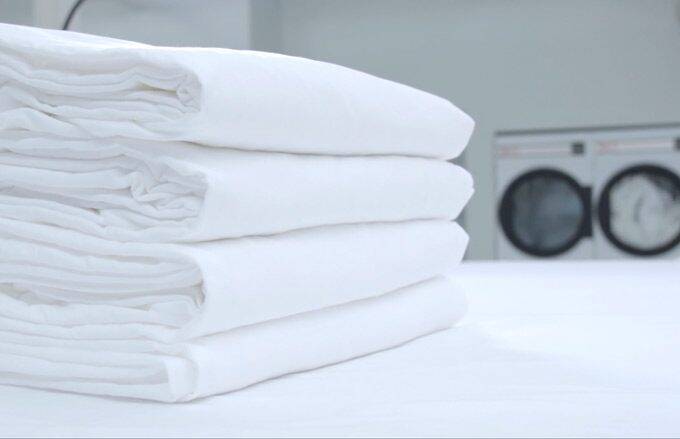August 17, 2022
Hotel Laundry 101: How to Keep your Laundry Running Smoothly

Between general labor shortages and COVID-19, many properties have struggled with staffing to keep their hotel laundry running smoothly. In some cases, managers & administrative staff have found themselves becoming the de facto laundry manager, with little or no experience.
Industrial laundry is a specialized field that is quite different from the at-home laundering we’re all used to. To help ensure your hotel laundry runs smoothly, we’ve compiled our top 8 keys to success for a new, inexperienced hotel laundry manager.
Get Comfortable with Hotel Laundry Chemicals
When you first step into a hotel laundry, you will likely be confused by the labels you see on the chemicals. One of the first steps is to ensure you understand what each chemical is and how it should be used.
- Detergent: Contrary to popular belief, a detergent’s primary role in washing is to suspend dirt and soil in water. The mechanical action of the washing machine causing the soils to loosen and release into the water, where they become suspended by the detergent. This prevents the contaminant from redepositing onto the linens and allows the dirty water to be easily removed.
- Alkali: Alkalis (such as Borax, Sodium Hydroxide) are added along with detergent to help enhance the performance of the detergent and assist in the removal of oily type soils. They also combat calcium and hard water to provide an optimal cleaning environment.
- Built Detergent: Contains both Alkali and Detergent together.
- Bleach: The addition of bleach serves several roles, including whitening cotton fibers, removal of protein-related stains, and as a disinfectant. There are many types of bleaches, such as Sodium Hypochlorite, Hydrogen Peroxide, and Peracetic Acid. Bleach type and amounts should be carefully selected according to the manufacturer recommendations.
- Antichlor: This chemical is used to neutralize chlorine beach. This product is commonly used to prevent yellowing from residual bleach, or with pool towels, which are subject to chlorine in their normal use.
- Sour: Souring chemicals are used to neutralize the alkali chemicals added at the beginning of the wash. Souring brings the pH of the linens down to 5.5-6.5, avoiding skin irritation and discomfort for guests. It also avoids any discoloration that can be caused by leftover alkali.
- Softener: Softeners use in hotel laundry is the same as at-home laundry. Note that liquid softeners are used in the wash process and not in the dryer like common household dryer sheets.
Separate Loads by Type
Since most hotel linens are white, it can be tempting to combine them all into one load. However, different product types (such as sheets and towels) require different wash cycles and drying times. In addition, towels can become “balled up” inside of sheets, reducing the effectiveness of the wash. Separating linens by type is essential to ensuring a thorough clean and maximizing the life of your linens.
Understand the Hotel Laundry Wash Cycle
While at home washing machines offer pre-set wash cycles (such as delicate, bedding, or normal) industrial washing machines allow each step in the washing process to be programed with a length, function, and temperature. Here is a basic breakdown of each step:
- Flush: The flush step consists of adding a high level of water to the load at a medium temperature (typically 100°F). The goal of flushing is to begin loosening soils or stains and preparing the linens for the rest of the wash cycle. The flush step typically lasts between 2 and 3 minutes.
- Break: The goal of this step is to “break” the remaining soil loose from the linen. This is achieved through traditional mechanical action (agitation) and the use of a nonionic detergent and/or an alkaline product. This step uses a reduced water level and higher temperature (typically 140°F -160°F). The break step typically lasts 6-8 minutes.
- Suds: After the break step, a suds step is often added. The water level and temperature remain unchanged; however, additional chemicals are added during suds (typically half the level used during break). The suds step typically lasts 8-12 minutes.
- Bleach: For products that require it, a whitening agent is added at a low water level and high temperature (typically between 140-170°F depending upon the bleach type). This step typically runs for 8-10 minutes.
- Rinse: Typically, most wash cycles will involve 2-3 rinses to ensure complete soil and chemical removal. Each rinse cycle lasts approximately 2-3 minutes and a gradually decreasing water temperature is used with each rinse (1st rinse: 130-145°F; final rinse: 100-115°F). If needed, antichlor product would be added during the last rinse step.
- Sour: Due to the alkaline product added earlier, the linens currently have a very high pH, which could cause skin irritation and guest discomfort. By adding a souring agent, the pH is balanced at a level similar to that of our skin (5.5-6.5). This step is completed in 5 minutes using a low water level at approximately 100°F. Softeners are sometimes added during this step as well.
- Soften: Unlike at-home laundry, there are many hotel linens that do not require softening. However, if your load requires softening, these chemicals can be added during the sour step and completed at the same time.
- Extract: This final step uses high speed spinning to remove excess moisture from the load, reducing the amount of dry time needed. This step can run at varying speeds and for lengths of 2-12 minutes depending on fabric type.
Different types of linens require different wash cycles. It is critical that you understand the make up of your linens and choose your wash cycle appropriately. Consult your linen manufacturer for recommendations if necessary.
Master the Art of Drying
Most laundry novices don’t realize that over-drying is one of the easiest ways to cause wrinkles and shrinkage in your textiles. Believe it or not, you should never dry your hotel laundry until the items are bone dry. Cotton in its “dry” state holds about 7-8% of its weight in water. Without this moisture, the fabric will be somewhat limp and prone to shrinkage and wrinkles. To avoid this, linens should still be slightly damp when removed from the dryer.
Another important tip is to utilize a cool down cycle. The hotter the fabric, the more prone it will be to wrinkle or shrink. Make sure your dryer programming includes a cool-down cycle and use it. That drop in temperature will help the fibers relax and minimize the potential for wrinkling.
A final step to avoid wrinkles is to fold immediately after drying. When folding, try to smooth out any creases or wrinkles that are present.
How to Deal with Stains
Let’s face it, stains are an inevitable part of hotel laundry. Properly treating and removing stains can save your property considerably, since staining is one of the most common causes of discarding used linen.
The key to stain control is to spot treat as quickly as possible. The longer a stain sits in a room, the more set in that stain will become. In addition, stained items should be separated from non-stained items and washed separately. You will want to keep a close eye on these “stained loads” to ensure full stain removal. If the first wash is unsuccessful, you will need to attempt to repeat the process before drying. Drying will cause a stain to become fully set and impossible to remove.
Feeling overwhelmed by stains? Check out our comprehensive guide to Tackling Cosmetic Stains.
Know When to Iron
Not all products require ironing, however, some items may. Consult your fabric care instructions if you are unsure. Many hotel laundry operations use what is called a flatwork ironer. A flatwork ironer is made up of a large, heated roller. When passing through this roller, the items are both ironed and dried. While this piece of equipment can be a huge time saver, you’ll want to ensure you have been properly trained on how to safely operate the iron.
While flatwork irons dry products while operating, we do not recommend you completely skip the drying phase. Instead of a full drying cycle, we recommend a “pre-condition” of 5-10 minutes after washing. This step will ensure proper moisture content and will help maximize product life.
Have Enough Product on Hand
Not having enough clean linen for your housekeeping staff is a problem you don’t want to encounter. Thankfully, there is a simple way to avoid this problem. Par level (or Periodic Automatic Replacement) is a system that calculates the minimum inventory your properties should keep in stock to avoid shortages. The par level of a hotel should be at least 3 par, or 3 complete sets of bedding and towels per room. This allows for one set in the room, one set on the shelf, and one set in the laundry. Many properties go beyond this and carry 3.25 par. This allows a small buffer to account for loss, damage, or wear and tear.
Let your Linen Rest
Lack of a proper par level will mean that your housekeepers will be taking linen straight from the dryer to their rooms. While you might think this is nothing to worry about, it is actually a worst-case scenario for your linens. Without proper rest, cotton products can begin to lose strength and durability. In addition, using immediately after laundering can lead to guest complaints of “scratchy” sheets or towels. To avoid this, allow product to rest on laundry shelves for 24 hours. This rest period allows the cotton fibers to re-hydrate and will ultimately extend the life of your bedding and towels.
Need further support with your laundry operations?
Standard Textile’s dedicated team of textile and laundry experts are here for you. Contact us today to discuss your property’s linen challenges and keep your hotel laundry running smoothly.
Related Content

Common Laundry Mistakes that Can Ruin Hotel Linens
Let’s explore important laundry DON’Ts from our laundry experts that will keep your linens in tip top shape.

Summer School’s in Session! Anatomy of a Bed 101
Summer 2021 looks so much sunnier than last year, and we’d like to help you keep your skills sharp as guests continue to return to travel. We’re kicking off a series of easy go-to guides that you can use to boost the guest experience while keeping a careful eye on your budget—and we promise: no…

VIDEO: 5 Tips to Help Your Hotel Laundry Reduce Wrinkles
Proper laundry procedures can help prevent wrinkles, as well as extend product life. But there are ways to minimize wrinkles with just a few simple steps.